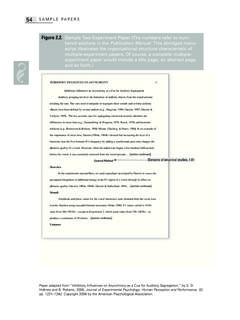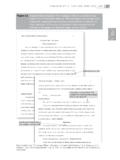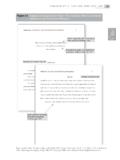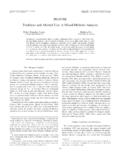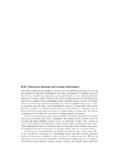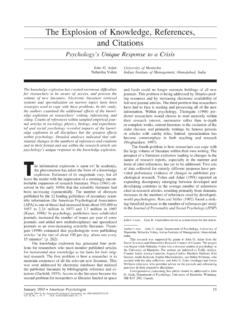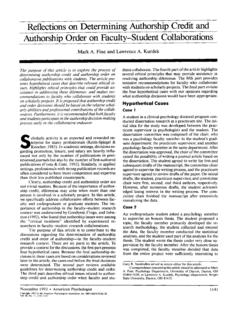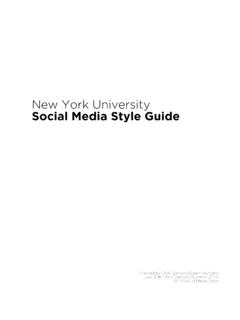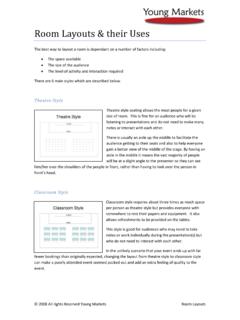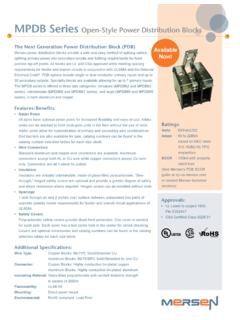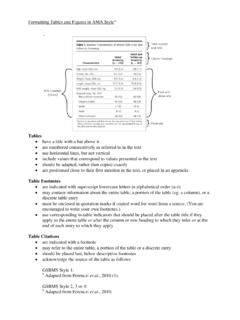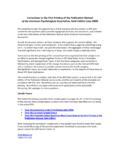Transcription of 11353-01 Intro final - APA Style
1 Introduction T. he Publication Manual of the American Psychological Association was first published in 1929 as a seven-page standard of procedure, to which exceptions would doubtless be necessary, but to which reference might be made in cases of doubt (Bentley et al., 1929, p. 57). Eighty years later, we launch the sixth edition of the Publication Manual in the same spirit. Over the years, the Publication Manual has grown by necessity from a simple set of Style rules to an authoritative source on all aspects of scholarly writing, from the ethics of duplicate publication to the word choice that best reduces bias in language.
2 The rules of APA Style are drawn from an extensive body of psychological litera- ture, from editors and authors experienced in scholarly writing, and from recognized authorities on publication practices. This edition of the Publication Manual has been extensively revised to reflect new standards in publishing and new practices in infor- mation dissemination. Since the last edition of the manual was published, we have gone from a population that reads articles to one that consumes content. New tech- nologies have made increasingly sophisticated analyses possible, just as they have accelerated the dissemination of those analyses in multiple forms, from blogs to per- sonal Web postings to articles published in online databases.
3 To provide readers with guidance on how these and other developments have affected scholarly publishing, we have reordered and condensed the manual signifi- cantly. Our first goal was to simplify the reader's job by compiling all information on a topic in a single place. We have ordered information in accordance with the publica- tion process, beginning with the idea stage and ending with the publication stage. We have retained and strengthened the basic rules of APA writing Style and the guidelines on avoiding bias in language that were first published by APA more than 30 years ago.
4 Most important, we have significantly expanded guidance on ethics, statistics, journal article reporting standards, electronic reference formats, and the construction of tables and figures. 3. 4 O R G A N I Z AT I O N O F T H E S I X T H E D I T I O N. Key to this revision is an updated and expanded web presence, which exponential- ly increases the information we are able to provide. At , readers will Bias find a full range of resources for learning APA Style as well as additional guidance on writing and publishing, which will evolve with changing standards and practices. Organization of the Sixth Edition In Chapter 1, we acquaint readers with the types of articles common in scholarly pub- lications.
5 We also describe the role of ethics in publishing and offer guidance in follow- ing best practices for compliance. In Chapter 2, we define all parts of a scholarly manuscript, from title to appendix, emphasizing both function and form. We also summarize current reporting standards for journal articles. The chapter ends with sample papers that illustrate the rules of APA Style . In Chapter 3, we offer basic guidance on planning and writing the article. We advise readers on how to organize their thoughts, choose effective words, and describe individuals with accuracy and sensitivity.
6 In Chapter 4, we instruct readers on the nuts and bolts of Style : punctuation, spelling, capitalization, abbreviations, numbers, and statistics in text. Consistency in the use of these basic aspects of Style is key to clear scientific communication. In Chapter 5, we describe the effective use of graphic elements in text and provide readers with illustrations of graphic elements that are useful for the presentation of data in tables and figures. In Chapter 6, we provide guidance on citing sources. We discuss ground rules for acknowledging contributions of others and for formatting quotations.
7 We instruct readers on when and how to cite references in text and on how to construct a refer- ence list that contains everything readers need to locate each source. In Chapter 7, we provide a comprehensive selection of reference examples in APA. Style . The examples cover a range of categories, from periodicals to podcasts, with an emphasis on references to electronic formats. In Chapter 8, we provide an overview of the journal publishing process. We emphasize the author's responsibilities in manuscript preparation and at each subse- quent stage of publication. Specific Changes in the Sixth Edition General Approach We considered two broad issues in planning this revision.
8 First, given the wide use of the Publication Manual by readers outside the field of psychology, to what extent should this edition focus specifically on the APA journals program? Detailed infor- mation on APA journals is available on the web (see );. each journal has its own web page, which includes specific instructions to authors. We decided to remove from the Publication Manual much of the APA-specific information that is readily accessible on the web, where guidelines are kept current. In this edition of the Publication Manual, we emphasize general principles that researchers need to know as well as principles of clear textual and visual communication.
9 INTRODUCTION 5. Second, to what extent should the Publication Manual be prescriptive rather than descriptive of current practices in the field? A section in the foreword to the fourth edi- tion is relevant: The Publication Manual presents explicit Style requirements but acknowledges that alternatives are sometimes necessary; authors should balance the rules of the Publication Manual with good judgment. Because the written language of psychology changes more slowly than psychology itself, the Publication Manual does not offer solutions for all stylistic problems. In that sense, it is a transition- al document: Its Style requirements are based on the existing scientific literature rather than imposed on the literature.
10 (American Psychological Association, 1994, p. xxiii). Because of the diversity of practices in the social and behavioral sciences, we antici- pated that the Publication Manual would likely prescribe new direction for some subdisciplines and merely describe the current state of scientific reporting for other subdisciplines. New and Expanded Content Chapter 1. Because of the importance of ethical issues that affect the conduct of scien- tific inquiry, we have placed ethics discussions in this opening chapter and have signif- icantly expanded coverage of several topics. New guidance is included on determining authorship and terms of collaboration, duplicate publication, plagiarism and self- plagiarism, disguising of participants, validity of instrumentation, and making data available to others for verification.
